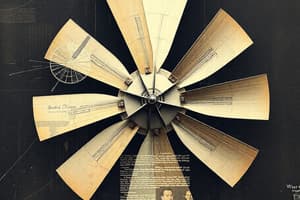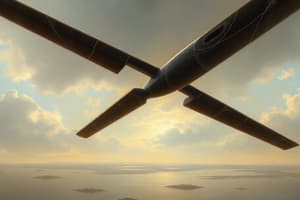Podcast
Questions and Answers
Which of the following is NOT a common material used in the construction of rotor blades?
Which of the following is NOT a common material used in the construction of rotor blades?
- Wood
- Metal
- Composite
- Plastic (correct)
What is a primary inspection method used for composite rotor blades?
What is a primary inspection method used for composite rotor blades?
- X-raying
- Tap testing (correct)
- Visual inspection
- Ultrasonic testing
Where are spanwise balance weights typically located on a rotor blade?
Where are spanwise balance weights typically located on a rotor blade?
- Leading edge
- Blade tip and center on the spanline. (correct)
- Trailing edge
- At the root
Where are chordwise mass balance weights typically located?
Where are chordwise mass balance weights typically located?
If you needed to adjust a helicopter to fly higher in the plane of rotation using weights, where would you add weight?
If you needed to adjust a helicopter to fly higher in the plane of rotation using weights, where would you add weight?
What must be completed first when rigging a helicopter?
What must be completed first when rigging a helicopter?
What is the final check done before a helicopter is signed off after maintenance?
What is the final check done before a helicopter is signed off after maintenance?
Where is the servo flap located on the rotor blade?
Where is the servo flap located on the rotor blade?
What is a primary advantage of an asymmetrical rotor blade design?
What is a primary advantage of an asymmetrical rotor blade design?
Why are symmetrical rotor blades the most commonly used design?
Why are symmetrical rotor blades the most commonly used design?
What is a characteristic of a uniform rotor blade planform?
What is a characteristic of a uniform rotor blade planform?
What is a disadvantage of using a tapered rotor blade planform?
What is a disadvantage of using a tapered rotor blade planform?
Why are rotor blades constructed using a bonded method?
Why are rotor blades constructed using a bonded method?
What is a key advantage of a multi-pocket rotor blade construction?
What is a key advantage of a multi-pocket rotor blade construction?
What will happen if weight is added to the front of a rotor blade?
What will happen if weight is added to the front of a rotor blade?
What is the purpose of a matte black paint finish on the bottom of rotor blades?
What is the purpose of a matte black paint finish on the bottom of rotor blades?
Flashcards
Tap testing
Tap testing
A method used to inspect composite rotor blades by tapping on the surface to detect any damage or voids.
Double plates
Double plates
Additional plates added to the root of the rotor blade tip, increasing structural strength without adding weight.
Spanwise balance weights
Spanwise balance weights
Weights attached to the blade tip, along the center of the spanline, ensuring stability and balance.
Chordwise mass balance weights
Chordwise mass balance weights
Signup and view all the flashcards
Tracking weights
Tracking weights
Signup and view all the flashcards
Servo flap
Servo flap
Signup and view all the flashcards
Rigging
Rigging
Signup and view all the flashcards
Autorotational check
Autorotational check
Signup and view all the flashcards
Symmetrical Rotor Blade
Symmetrical Rotor Blade
Signup and view all the flashcards
Asymmetrical Rotor Blade
Asymmetrical Rotor Blade
Signup and view all the flashcards
Parallel (Uniform) Planform
Parallel (Uniform) Planform
Signup and view all the flashcards
Tapered Planform
Tapered Planform
Signup and view all the flashcards
Negative Twist Blade
Negative Twist Blade
Signup and view all the flashcards
Single Pocket Construction
Single Pocket Construction
Signup and view all the flashcards
Multi Pocket Construction
Multi Pocket Construction
Signup and view all the flashcards
Rotor Blade Balance
Rotor Blade Balance
Signup and view all the flashcards
Study Notes
Rotor Blade Designs
- Symmetrical blades have better aerodynamic pitch characteristics.
- Asymmetrical blades provide greater lift for the same surface area, due to higher camber on one side.
- Engineers achieve similar pitching characteristics in asymmetrical blades through sweeping the edges 3 degrees upwards.
- Symmetrical designs are more common due to the instability of asymmetrical designs.
- Rotor blades are designed in parallel (uniform) or tapered configurations.
- Uniform blades maintain parallel leading and trailing edges, maximizing lift due to constant chord length.
- Tapered blades converge towards the tip, decreasing chord length, and offering more even lift across the blade.
- Manufacturers favor uniform blades for cost-effectiveness due to simpler manufacturing processes.
Rotor Blade Construction
- Bonded construction is stronger and eliminates the need for drilling holes.
- Single-pocket designs are quicker to build but more susceptible to damage.
- Multi-pocket blades offer easier repair options.
- Trim balance weights are located at the tip and 30-50% along the span, and are adjusted to control lift.
Rotor Blade Features
- Erosion protection is ensured by stainless steel caps on leading edges, protecting against air particles.
- Matte black paint is used to prevent glare.
- Composite, metal, or wood materials are used, and tap testing is a key inspection method.
- Multi-pocket blades are more expensive to build but may feature double plates at the root to increase strength.
Helicopter Control Systems
- Balance weights are critical in controlling the plane of rotation.
- Trim tabs are used to adjust the helicopter height.
- Collective hydraulics are connected to the throttle.
- Separate servo flaps on the trailing edge enhance the aerodynamic response.
- Hydraulic systems reduce vibrations and noise.
- Simplified blade designs increase flight efficiency, reaction time for auto-rotation.
Studying That Suits You
Use AI to generate personalized quizzes and flashcards to suit your learning preferences.




